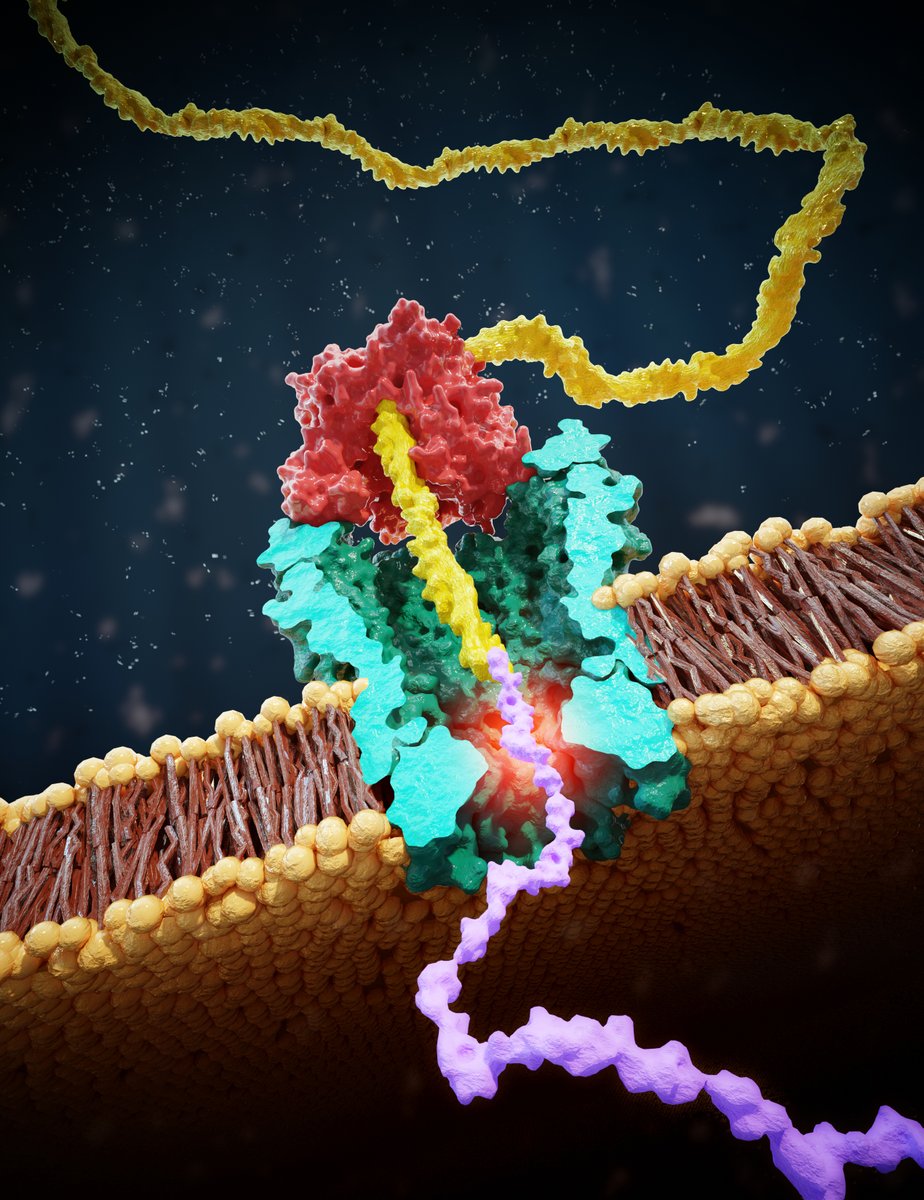
Today, we put 2 new #CDlab papers on the @arxiv preprint server – which both report, in different ways, on demonstrating nanoscale rotary motors that are driven by a flow through a nanopore.
arxiv.org/pdf/2206.06612…
arxiv.org/pdf/2206.06613…
1 /

arxiv.org/pdf/2206.06612…
arxiv.org/pdf/2206.06613…
1 /


@arxiv Such rotors are inspired by the awesome F0F1 ATPase motor protein in our cells. Here, a proton gradient drives rotation of F0 which induces conformational changes in F1 that catalyze production of ATP, which is the fuel for most processes in our body.
Video credit Biovisions
2/
Video credit Biovisions
2/
We built similar rotary motors synthetically from the bottom up, using ‘DNA origami’ in great collaboration with @hendrik_dietz lab. These motor structures dock onto a nanopore and autonomously show sustained unidirectional rotations where a rod rotates at >10 rotations/sec.
3/
3/
@hendrik_dietz In a first approach (paper 1 arxiv.org/abs/2206.06613), we demonstrate a self-organized artificial nanoscale rotary machine, where a simple DNA bundle acts as the rotor that self organizes onto a nanopore in a thin solid-state membrane that serves as stator and flow generator.
4/

4/


Video’s often tell the story in less words – so here’s a movie where you see the fluorescently labelled end of a rotating DNA bundle that is observed to move in a circle around the nanopore that is located at the center.
5/
5/
Energy is provided by applying a static applied DC voltage.
Or even simpler: by merely having different salt concentration on the two sides of the membrane (think salt water versus fresh water)!
The latter directly mimics F0F1 where a concentration gradient drives rotation.
6/
Or even simpler: by merely having different salt concentration on the two sides of the membrane (think salt water versus fresh water)!
The latter directly mimics F0F1 where a concentration gradient drives rotation.
6/

So how is this rotation driven?
As the elastic and highly charged bundle docks on the pore, it gets compressed by the field into a chiral shape. This asymmetrically couples to the radial water flow out of the pore, which exerts an angular force that drives the rotation.
7/
As the elastic and highly charged bundle docks on the pore, it gets compressed by the field into a chiral shape. This asymmetrically couples to the radial water flow out of the pore, which exerts an angular force that drives the rotation.
7/

Like in this simulation movie…
8/
8/
We deduced this self-organized rotor mechanism in a wonderful collaboration with the @RGolestanian lab who did extensive simulations on this – see the results for different initial docking configurations where bundles are placed off center in various ways
9/
9/
@RGolestanian Read all about these self-organized DNA rotors in our preprint (soon to be published in Nature Physics):
arxiv.org/pdf/2206.06613…
10/
arxiv.org/pdf/2206.06613…
10/

In a second paper (arxiv.org/pdf/2206.06612…), advanced rational origami design by the @hendrik_dietz lab defined a true nanoscale turbine, with right-handed or left-handed chiral blades.
Its mere ~20 nm scale mimics the size of the F0F1 ATPase.
11/
Its mere ~20 nm scale mimics the size of the F0F1 ATPase.
11/

@hendrik_dietz Upon applying a (reinforced 16hb) DNA rod as load, we again measured sustained unidirectional rotations.
And now, the rotation direction was set by chirality! Lefthanded turbines rotated clockwise; righthanded ones rotated anticlockwise
12/
And now, the rotation direction was set by chirality! Lefthanded turbines rotated clockwise; righthanded ones rotated anticlockwise
12/

And, very surprising:
In high salt buffer, the DNA nanoturbines rotated in the opposite direction compared to rotation in low salt!
13/
In high salt buffer, the DNA nanoturbines rotated in the opposite direction compared to rotation in low salt!
13/

Here, full-atom MD simulations by @aksimentievLab (with 4.3 million atoms!) came to the rescue, as they showed the flow-driven rotation as well as the rotation-direction reversal at high salt, caused by a different ion distribution near the DNA that reverses the force on it.
14/
14/
This was all really a technical tour-de-force: from the origami design, to docking turbines correctly, to nanoscale detection, and to puzzling out the mechanisms involved.
Very gratifying that 7 years after the conception of these ideas, this now materialized in 2 papers!
16/
Very gratifying that 7 years after the conception of these ideas, this now materialized in 2 papers!
16/
Our nanoturbines are the first-ever experimental realization of flow-driven rotors at the nanoscale, constituting a new class of molecular motors. These synthetic machines convert energy from a static electrochemical gradient into useful mechanical work.
17/
17/
These artificial turbines operate autonomously in physiological conditions. Next to better understanding motor proteins such as F0F1 ATPase, the results open new perspectives for engineering active robotics at the nanoscale.
18/
18/
NB All this was teamwork (see above), but most credits go to 1st author @xinshi_d, who led this challenge as postdoc in our #CDlab
Xin is on the job market now and will continue this work as tenure track assistant professor. I greatly recommend him, so get him while you can!
19/
Xin is on the job market now and will continue this work as tenure track assistant professor. I greatly recommend him, so get him while you can!
19/

• • •
Missing some Tweet in this thread? You can try to
force a refresh







